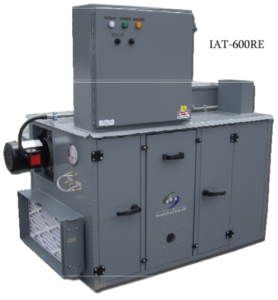In Part 2: How It Works of this series, we learned that the silica gel rotor was the key development which allowed for one continuous process with two separate air flows for moisture adsorption and silica gel regeneration. In Part 3, I’ll explain how we customize a desiccant dehumidifier for some common applications.
Cold Storage/Freezer
 A significant problem for cold storage areas and freezers is moisture infiltration. When not properly controlled, excessive moisture results in condensation or ice that can reduce worker productivity, increase cooling costs, and increase safety risks. Although there are ways to reduce the moisture infiltration rate, the best method for controlling moisture for these cold environments is with a desiccant dehumidifier.
A significant problem for cold storage areas and freezers is moisture infiltration. When not properly controlled, excessive moisture results in condensation or ice that can reduce worker productivity, increase cooling costs, and increase safety risks. Although there are ways to reduce the moisture infiltration rate, the best method for controlling moisture for these cold environments is with a desiccant dehumidifier.
The most critical part of customizing a desiccant dehumidifier for a cold environment moisture control application is accurately determining the moisture load that comes from these four sources:
- Amount of time people spend inside
- Type of products stored
- Number of openings and how long they are open
- Construction materials used for walls, ceilings and floors
Another important issue to customize a desiccant dehumidifier is determining the amount of post-cooling required. Because the desiccant dehumidifier will be reducing the latent cooling load in the cold environment, there may be some capacity in the chiller or Dx unit that is cooling the space. If there is no capacity, then the amount of post-cooling will be determined by the temperature set point for the cold environment.
Pneumatic Conveying
 Using air to convey products around a manufacturing facility is a common practice because of the simplicity of the process. However, when moving materials that can easily absorb moisture, the moisture content in the air must be tightly controlled. A desiccant dehumidifier works well in this application because it can be customized to deliver a constant volume, at a constant temperature and below a certain moisture level.
Using air to convey products around a manufacturing facility is a common practice because of the simplicity of the process. However, when moving materials that can easily absorb moisture, the moisture content in the air must be tightly controlled. A desiccant dehumidifier works well in this application because it can be customized to deliver a constant volume, at a constant temperature and below a certain moisture level.
Customizing a desiccant dehumidifier to keep a constant volume of air below a certain moisture level requires knowing the moisture content of the supply air to the desiccant dehumidifier. More importantly, it is knowing the maximum moisture content of the supply air which will determine the size the desiccant gel rotor or if pre-cooling is needed to remove the peak amount of moisture and still stay below the moisture level target.
After the desiccant dehumidifier has been customized for moisture control, we can determine how it should be customized with post-cooling to deliver air at the temperature target. This will depend on the temperature of the supply air and whether any pre-cooling has been incorporated for moisture control.
Pill Stamping
The process of stamping pills may require a very narrow moisture range. If the air is too dry, the pills may crumble or pick-up static electricity. If the air is too moist, the pills may stick to the stamping machine. Keeping the environment of the pill stamping area within a narrow moisture range requires customizing the desiccant dehumidifier to do more than just cycle on and off.
There are three ways a desiccant dehumidifier can be customized to keep a narrow moisture range. All three of these methods require that the desiccant dehumidifier is continuously operating:
- Turn the regeneration heat on and off
- Modulate the regeneration heat
- Use face and by-pass air flows
These methods are progressively more expensive to use for moisture control. Thus, the best method for an application will depend on how tightly the moisture level is to be controlled and a trade-off between operating costs and defective product costs.
Conclusion
I hope that from the discussion of these examples you have obtained a sense for how complex it can be to customize a desiccant dehumidifier for any application. It takes knowledge and experience to know how to collect the right information and balance all of components within a desiccant dehumidifier to determine the right solution for each application. 
Eldridge is very fortunate to partner with Innovative Air Technologies (IAT) in providing desiccant dehumidifier solutions to our customers. IAT has been supplying desiccant dehumidifiers for almost 20 years to manufactures that make many of the products that you consume and enjoy every day. If you have a complex dehumidification problem that needs to be solved, the Eldridge and IAT team will find a solution that will provide a successful moisture environment for your business.
